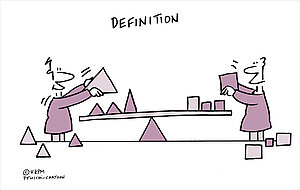Negotiation
Definition
Negotiation is the process between two or more parties that aims to balance different interests, needs and expectations in order to reach a common agreement and commitment while maintaining a positive working relationship. Negotiation includes both formal and informal processes such as buying, hiring or selling or regarding requirements, budget and resources in projects.
Purpose
The purpose of this competence element is to enable the individual to reach satisfactory agreements with others by using negotiation techniques.
Description
Agreements are based on positions that will satisfy the interests, needs and expectations of all parties. Negotiations can be political or commercial and can often entail reaching compromises that do not leave all parties very satisfied. Interests, needs and expectations often involve emotions and feelings as well as facts and the full picture may not be easy to identify. The negotiating process is often influenced by the relative power of the parties and by situational factors that may be called ‘leverage’.
Negotiators need to research these issues and, when full information is not available, make assumptions about them. Successful negotiation is facilitated by developing a number of options, each of which has the potential to satisfy different interests, needs and expectations. Negotiation may involve the use of different techniques, tactics and strategies.
Key competence indicators
Identify and analyse the interests of all parties involved in the negotiation
Understanding the priorities of the parties to the negotiation is a prerequisite to generating a successful outcome. The individual leading or participating in the negotiations should begin by gathering hard and soft information about interests, needs and expectations of all parties by whatever means are available. Analysis of this information should reveal both priorities and gaps for further research. Priorities of other parties may often have to be assumed.
Measures
- Knows and reflects own interests, needs and constraints
- Gathers and documents relevant hard and soft information about interests, needs and expectations of all parties involved
- Analyses and documents available information to identify own priorities and likely priorities for other parties
Develop and evaluate options and alternatives with the potential to meet the needs of all parties
The individual identifies trade-offs, options and alternative negotiation solutions. They are developed during the preparation for negotiation and may be modified during the negotiations as opportunities emerge and the situation changes. The trade-offs, options and alternatives should be tuned to the interests of the negotiating parties, to be useable during the negotiation process. A best alternative to a negotiated agreement (BATNA) should also be identified.
Measures
- Identifies trade-offs, options and alternative solutions based on the analysis of interests, needs and priorities of all parties
- Proposes the right option at the right time in the right way
Define a negotiation strategy in line with own objectives that is acceptable to all parties involved
The negotiation strategy focuses on what the individual thinks is essential for a successful outcome. Before starting the negotiation, the individual must select the strategy, techniques and tactics that will enable him or her to reach an optimal outcome for the project. The strategy may depend upon factors such as the power balance between the parties, the stakes involved, budgetary conditions, politics, cultural aspects and the capability of the negotiators. The selected strategy should be appropriate to the interests of the project and not detrimental to relationships with the stakeholders involved. The individual should also consider secondary strategies that cover ‘what if’ scenarios.
The strategy also includes who the negotiators will be and what will be their mandate (negotiation scope, freedom, roles and responsibilities). In some cases a choice is also possible about the other party and/or negotiation scope (with whom to negotiate over what). This option should be carefully considered, as this choice might have negative or positive repercussions later on.
Measures
- Identifies possible negotiation strategies in order to achieve the desired outcome
- Identifies secondary strategies and alternative options to address ‘what if’ scenarios
- Selects a negotiation strategy and can explain why it has been chosen
- Analyses and selects negotiation techniques and tactics to support the desired negotiation strategy
- Identifies key parties to participate in the negotiation and clearly articulates their mandate
Reach negotiated agreements with other parties that are in line with own objectives
An agreement is reached through negotiation using the identified strategies, tools and tactics without alienating the other parties involved. Negotiation may occur over an extended timeframe and may proceed in phases. A satisfactory agreement is one in which all parties are reasonably satisfied with the result, will honour their commitments, think the other parties negotiated fairly and feel respected and will negotiate again. If an agreement is not achievable or the possible outcomes are not acceptable, the BATNA is implemented.
The best possible solution is often one that is sustainable and provides the best long-term results for all parties. There may be specific situations where this is not possible or preferable and a compromise may be required to meet one’s desired outcome. In many situations, the agreed outcomes are documented for future reference.
Measures
- Negotiates using techniques and tactics appropriate to the circumstances to achieve the desired outcome
- Negotiates to achieve a sustainable agreement
- Demonstrates patience and drive to realise a sustainable agreement
- Implements BATNA if a sustainable outcome is not possible
- Documents the outcomes of the negotiation
Detect and exploit additional selling and acquisition possibilities
The individual is constantly striving to realise the processes and agreed outcomes faster, better and/or cheaper. This means that the individual has to have a keen eye for opportunities to realise this aim. Depending on the situation, this may for instance mean searching for new suppliers or renegotiating old agreements, looking for ways to offer services to new clients, negotiating better conditions with stakeholders or inviting teams or team members to realise tasks sooner, better and/or cheaper. Negotiating will occur after the new opportunities are identified.
The desired state should be seen in the light of the best interests of the project and the organisation. Is the organisation best served with the present situation or with efforts to improve it? In considering this, the individual is aware that negotiations also take up time and effort and that present relationships with negotiation partners may be affected.
Measures
- Seeks ways to deliver the agreed outcomes sooner, better and/or cheaper
- Weighs alternatives to the current situation and agreements
- Considers the impact of alternatives on current relationships


